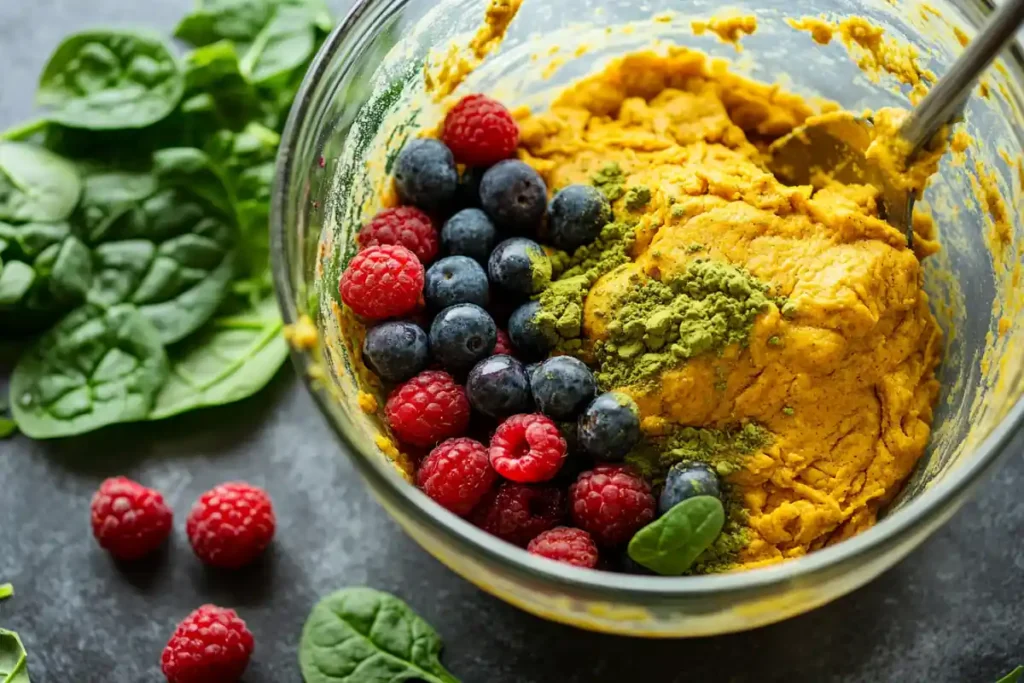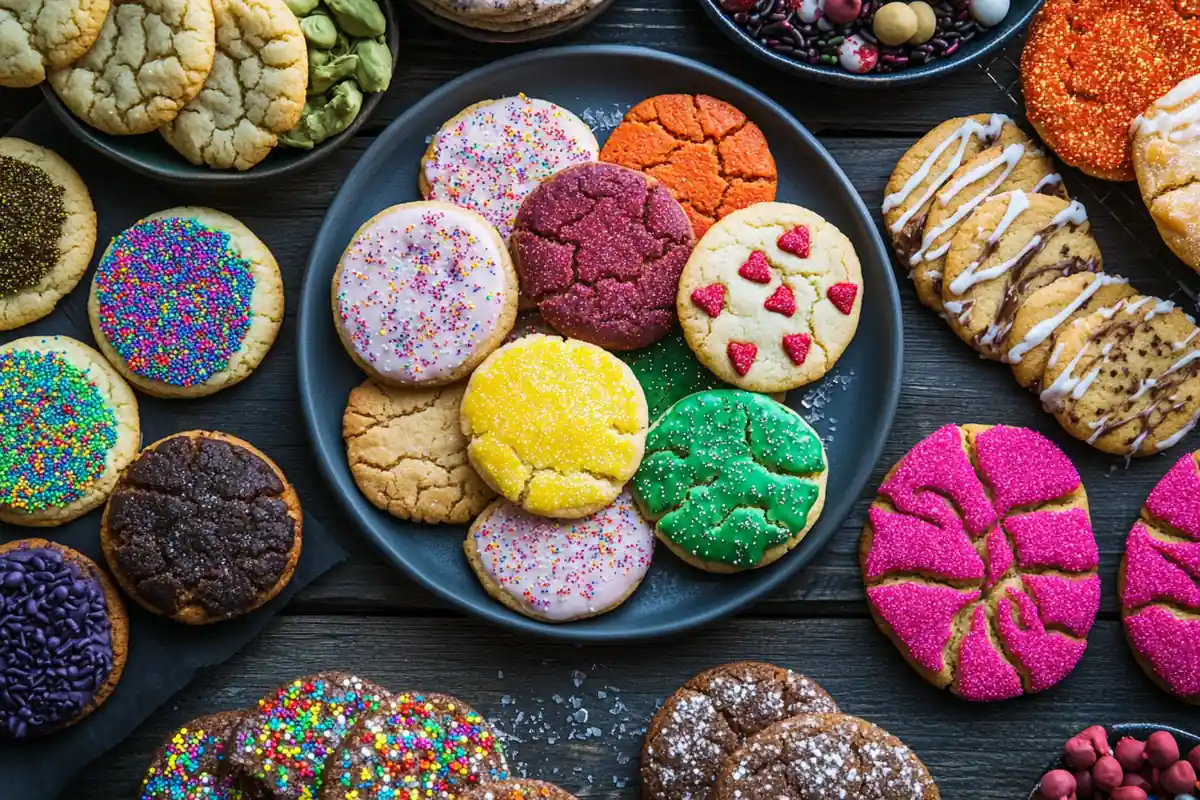Who doesn’t love a plate of freshly baked cookies? Now, imagine those cookies bursting with vibrant colors that make them as delightful to look at as they are to eat. In this article, we’ll dive into the world of colorful ingredients in cookie recipes, exploring how natural and artificial elements can transform your baking into a visual and flavorful masterpiece. From natural sources like fruits and vegetables to playful additions like sprinkles and food coloring, we’ll cover everything you need to know to create cookies that are as colorful as they are delicious. Whether you’re a seasoned baker or a beginner, this guide will inspire you to add a splash of creativity to your kitchen.
Introduction to Colorful Ingredients in Cookie Recipes
What Makes Ingredients Colorful?
When it comes to baking, colorful ingredients can come from both natural and man-made sources. Natural options include fruits like blueberries and strawberries, veggies like beetroot and spinach, and spices like turmeric and matcha powder. These ingredients not only add bright colors but also bring unique flavors and health benefits. On the other hand, artificial options like food coloring and sprinkles let you create bold, eye-catching designs with ease. The trick is to pick ingredients that not only make your cookies look good but also taste amazing. By balancing color and flavor, you can create treats that are as delicious as they are beautiful.
Why Use Colorful Ingredients in Cookies?
Let’s face it—we eat with our eyes first. Colorful cookies are more than just a treat; they’re a feast for the senses. Bright, vibrant hues can make your baked goods more appealing, especially to kids or anyone with a sweet tooth. Plus, experimenting with colorful ingredients can turn baking into a fun, creative activity. Whether you’re making cookies for a birthday party, a holiday celebration, or just because, adding a pop of color can make your creations stand out.
Moreover, using natural colorful ingredients can also boost the nutritional value of your cookies. For instance, spinach adds a green hue while packing in vitamins, and beetroot provides a rich red color along with antioxidants. So, not only do these ingredients make your cookies look amazing, but they can also make them a tad healthier.
In the next sections, we’ll explore specific colorful ingredients you can use, along with tips and recipes to help you create stunning, delicious cookies that are sure to impress.
Natural Colorful Ingredients for Healthy Cookie Recipes

Fruits and Berries: Nature’s Candy
When it comes to adding colorful ingredients to your cookie recipes, fruits and berries are a no-brainer. They’re not only vibrant but also pack a punch of natural sweetness and nutrients. For instance, dried cranberries can add a pop of red and a tangy flavor, while apricots bring a sunny orange hue and a chewy texture. Fresh berries like blueberries and raspberries are perfect for creating bursts of color and flavor in every bite. Plus, they’re rich in antioxidants, making your cookies a bit healthier.
If you’re looking for inspiration, try adding blueberries to your oatmeal cookies or mixing dried cherries into chocolate chip dough. The result? A delightful treat that’s as colorful as it is delicious.
Vegetables for a Pop of Color
Yes, you read that right—veggies can be a great addition to your cookie recipes! Spinach, for example, can be blended into the dough to create a bright green color without changing the taste much. Similarly, beetroot is a star when it comes to adding a rich red shade. It works especially well with chocolate, making it perfect for red velvet cookies.
Another great option is sweet potato. Its natural orange color gives your cookies a warm, cozy look, and its mild sweetness pairs well with spices like cinnamon and nutmeg. These colorful ingredients not only make your cookies look amazing but also add a healthy touch.
Spices and Powders for Natural Coloring
If you’re aiming for a more subtle approach, spices and powders are your best friends. Turmeric, for instance, can give your cookies a golden-yellow color and a slightly earthy flavor. It works wonders in recipes like turmeric and coconut cookies. On the other hand, matcha powder is perfect for creating a vibrant green shade while adding a unique, slightly bitter taste that pairs well with white chocolate or vanilla.
For a touch of purple, consider using blue spirulina powder or acai powder. These superfoods not only add color but also bring a host of health benefits. By incorporating these natural colorful ingredients, you can create cookies that are both beautiful and wholesome.
Artificial and Decorative Colorful Ingredients
Food Coloring: Liquid, Gel, and Powder Options
Sometimes, natural ingredients just don’t cut it when you’re aiming for bold, vibrant colors. That’s where food coloring comes in. Available in liquid, gel, and powder forms, food coloring allows you to achieve almost any shade imaginable. Gel food coloring, in particular, is a favorite among bakers because it’s highly concentrated and doesn’t alter the texture of the dough.
When using food coloring, start with a small amount and gradually add more until you reach the desired shade. For pastel colors, a drop or two is usually enough, while bold hues may require a bit more. Whether you’re making rainbow sugar cookies or red velvet cookies, food coloring can help you achieve the perfect look.
Sprinkles, Edible Glitter, and Decorative Toppings
If you want to take your cookies to the next level, decorative toppings are the way to go. Sprinkles are a classic choice, adding a fun, festive touch to any cookie. They come in countless shapes, sizes, and colors, making them perfect for themed cookies like birthday or holiday treats.
Edible glitter is another fantastic option for adding a touch of magic to your creations. It’s ideal for special occasions and can make your cookies sparkle like gems. For a more sophisticated look, try using colored sugar or edible pearls. These toppings not only enhance the visual appeal but also add a bit of texture to every bite.
When using these colorful ingredients, remember that a little goes a long way. Overloading your cookies with toppings can make them overly sweet or messy. Instead, aim for a balanced approach that highlights the beauty of your cookies without overwhelming them.
Top 10 Cookie Recipes Featuring Colorful Ingredients

Rainbow Sugar Cookies
If you’re looking to create a show-stopping dessert, rainbow sugar cookies are the way to go. These cookies are made by layering different colored doughs to create a vibrant, striped effect. Using food coloring or natural alternatives like spinach powder and beetroot powder, you can achieve a stunning rainbow look. Plus, they’re perfect for parties or as a fun baking project with kids.
Matcha Green Tea Cookies
For a unique twist, try matcha green tea cookies. The matcha powder not only gives these cookies a beautiful green color but also adds a subtle, earthy flavor. Pair them with white chocolate chips for a delightful contrast in both taste and appearance. These cookies are a great way to incorporate colorful ingredients while keeping things sophisticated.
Red Velvet Cookies with Cream Cheese Frosting
Red velvet cookies are a classic favorite, and their deep red hue makes them a standout treat. Using beetroot or red food coloring, you can achieve that signature color. Top them with a creamy cream cheese frosting for a perfect balance of sweetness and tanginess. These cookies are ideal for holidays or special occasions.
Blueberry Lemon Cookies
Mixing fresh blueberries and lemon zest, these cookies are packed with flavor and color. The blueberries give a natural purple-blue shade, while the lemon zest adds a zesty kick. These cookies are not only colorful but also light and refreshing, making them perfect for summer parties or a sweet snack any time of the year.
Turmeric and Coconut Cookies
For a healthy and vibrant option, try turmeric and coconut cookies. The turmeric gives these cookies a golden-yellow color, while the coconut adds a tropical flair. These cookies are packed with flavor and are a great way to sneak in some natural colorful ingredients.
Beetroot Chocolate Cookies
Beetroot chocolate cookies are a delicious way to incorporate vegetables into your baking. The beetroot adds a rich red color and a moist texture, while the chocolate complements its earthy flavor. These cookies are a hit with both kids and adults, and they’re a great way to make your treats a bit healthier.
Pistachio and Cranberry Cookies
If you want a festive treat, pistachio and cranberry cookies are a must. The green pistachios and red cranberries make a stunning mix, perfect for the holidays. They’re also full of flavor and crunch, making them a hit with everyone.
Lavender and Honey Cookies
For something special and fancy, try lavender and honey cookies. The edible lavender gives a soft purple color and a lovely floral scent, while the honey adds natural sweetness. These cookies are great for tea time or as a sweet homemade gift.
Mango and Coconut Cookies
Bring a taste of the tropics to your kitchen with mango and coconut cookies. The mango adds a sunny yellow color and a fruity sweetness, while the coconut provides a chewy texture. These cookies are a great way to use colorful ingredients for a summery vibe.
Funfetti Cookies
No list of colorful cookies would be complete without funfetti cookies. These cookies are loaded with colorful sprinkles, making them a hit at birthday parties and celebrations. They’re easy to make and always bring a smile to everyone’s face.
Tips for Baking with Colorful Ingredients
Balancing Flavor and Color
When using colorful ingredients, it’s important to strike a balance between flavor and appearance. For instance, while beetroot adds a vibrant red color, its earthy taste might not suit every recipe. Similarly, matcha powder can be slightly bitter, so pairing it with sweet ingredients like white chocolate can help balance the flavor. Always taste your dough before baking to ensure the flavors are harmonious.
Preventing Color Bleeding in Cookie Dough
One common challenge when working with colorful ingredients is color bleeding. To avoid this, make sure your dough is well-chilled before baking. This helps the colors stay distinct and prevents them from blending together. Additionally, when using food coloring, opt for gel or powder forms, as they are less likely to alter the dough’s consistency.
Storing Colorful Cookies to Maintain Vibrancy
To keep your cookies looking as vibrant as the day you baked them, store them in an airtight container. Exposure to air and light can cause colors to fade over time. If you’re using natural colorful ingredients like fruits or vegetables, consider adding a squeeze of lemon juice to the dough to help preserve the color.
FAQs About Colorful Ingredients in Cookie Recipes
Can I use natural ingredients to replace food coloring?
Absolutely! Many natural colorful ingredients can replace artificial food coloring. For example, beetroot can provide a deep red hue, while spinach or matcha powder can give your cookies a vibrant green color. Even spices like turmeric and cocoa powder can add rich shades without synthetic dyes.
What are the best natural sources for blue and purple colors?
Getting blue and purple colors naturally can be a bit tricky, but it’s not impossible. Blue spirulina powder is a great option for a bright blue shade, while acai powder or purple sweet potato can create lovely purple tones. For a simpler approach, blueberries can also add a subtle blue-purple hue to your cookies.
How do I prevent colorful ingredients from fading during baking?
To keep your colorful ingredients vibrant, avoid overbaking your cookies. High heat can cause natural colors to fade. Additionally, using gel or powdered food coloring instead of liquid can help maintain the intensity of the colors. For natural options, adding a bit of acidity, like lemon juice, can help preserve the color.
Are there any health benefits to using natural colorful ingredients?
Yes! Many natural colorful ingredients are packed with nutrients. For instance, spinach is rich in iron, beetroot is high in antioxidants, and turmeric has anti-inflammatory properties. By using these ingredients, you’re not only making your cookies look good but also adding a healthy twist.
Can I use frozen fruits and vegetables in cookie recipes?
Definitely! Frozen fruits like blueberries or raspberries work just as well as fresh ones. Just make sure to thaw and drain them properly to avoid adding extra moisture to your dough. Frozen vegetables like spinach can also be blended into the dough for a pop of color.
Conclusion:

Baking with colorful ingredients is a fun way to make your cookies stand out, turning them into bright, eye-catching treats that are as enjoyable to make as they are to eat. Whether you use natural options like fruits, veggies, and spices or try food coloring and fun toppings, the choices are endless. These ingredients not only make your cookies look great but also add special flavors and even health perks. So, feel free to get creative in the kitchen—mix, match, and try new ideas to make cookies that are as unique and colorful as you are. Happy baking!

